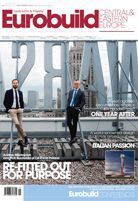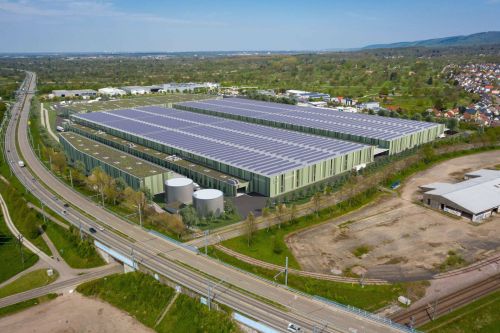Re-fitted out for purpose
Feature
Giving a building a catchy name and the printing of professional marketing materials are not enough these days to realistically compete on Warsaw’s hot office market. Branding specialists are now saying that what made investors successful a few years ago, has no raison d’źtre in the difficult market conditions nowadays. “Even the best marketing will not work if it is not supported by a good and credible product. Branding should start as early as the planning of a new office building or the renovation of an existing one. That is why we are more and more often working with investors to generate added value for the building itself before the marketing materials are produced,” explains Michał Nowakowski, the managing director at Bueller & Frye, a company specialising in the branding of office projects.
Apart from traditional marketing communication, Bueller & Frye now offers consultations on how to adapt buildings to create space that is attractive to tenants. Michał Nowakowski cites the Warsaw Trade Tower (WTT) as an example of the successful repositioning of a building and brand strengthening. Its owner, Akron Group, and its asset manager Heitman approached the task in a well-thought-out manner. “A team consisting of representatives of the owner, the branding agency and the architects worked on the repositioning from the very beginning, which made it possible to come up with a coherent and well thought-out brand while pooling the various competencies of our companies. All these activities followed an in-depth survey of tenants’ expectations” adds Michał Nowakowski. The response was very strong, out of almost 3,000 people working in the building, 1,300 completed the survey. “We invited anyone who wanted to fill in the questionnaire for a nice cup of coffee. It took us a month to collect all the questionnaires,” recalls Maria Bubak, the manager responsible for tenant relations in the building.
You cannot please everyone
According to Michał Nowakowski, the survey was not designed to address all their possible concerns, which was understood by the tenants themselves. However, the point is for the investor to understand tenants’ needs better and include them in the process of change. For example, according to WTT’s surveys, more than half of the employees bring their lunch from home at least three times a week. This influenced the owner’s decision to earmark an area of 170 sqm for a dining room including a itchenette equipped with microwaves and sinks, allowing employees to reheat the meals they bring from home. There are also tables, chairs and Wi-Fi access. Thus the staff do not have to eat at their desks or sit in the inadequately small kitchenettes tenants tend to provide for their employees. “The fact that the room is highly popular is proof that the idea has worked. Sometimes it is even difficult to find a free seat here at lunchtime,” says Maria Bubak. These are not the only areas that have been laid on for communal use by the owner recently. There is also a room (app. 50 sqm) for exercise and relaxation as well as a conference centre that covers app. half of the 35th floor. “They may not be completely free of charge, but the rates are competitive compared to those on the wider market,” claims Maria Bubak.
WTT is also the first building in Warsaw to offer the free rental of electric cars to its tenants. Every employee can rent a car for no fee for two hours a week. “The service is becoming more and more popular. A car can be reserved with one click through an application or a website,” says Maria Bubak. She admits, however, that these new amenities are a response to the growing competition to a certain extent. “Every manager tries to make their project unique in some way and stand out from the rest. We believe that the changes will make it possible for us to compete with other office buildings,” says Maria Bubak.
The survey also led to changes to the lobby. “Tenants wanted the area to be brighter and cosier. As well as that, they wanted more areas where they could sit down to have an informal meeting,” says Maria Bubak. Wooden elements were added to the walls and on the floor as well as live trees in plant pots. “At the time when the WTT building was being developed it was an office property of the grandest scale in Warsaw. Our strategy is to continue to set new trends and think what else an office building could offer its tenants,” emphasises Maria Bubak.
What are the worst mistakes that can be made when carrying out such changes? “Failing to familiarise yourself with current tenants’ expectations or market requirements and introducing only superficial, aesthetic changes, such as a new reception area, a new logo or marketing materials. Purely cosmetic changes may not be enough to increase competitiveness of the building and may even turn out to be an unprofitable investment,” argues Michał Nowakowski. To be effective, the repositioning and branding of a building should be based not only on a consideration of tenants’ needs, but it should also take into account the latest trends in workspace creation. ‘Employee well-being’ is an established buzzword in English management-speak, but it has now entered the lexicon in this part of the world.
Guardians of a decade-old portfolio
CA Immo has a portfolio of six Warsaw properties, each of which is already a dozen or so years old. Their central location is certainly their strong point; however, this should be no excuse for complacency. “I’m not going to hide the fact that a portfolio of properties with an average age of over ten years requires particular care from us in order to make sure they continue to be attractive,” says Andrzej Mikołajczyk, the head of CA Immo Poland. For the revitalisation of Warsaw Towers, which is currently in progress, CA Immo is making use of the results of a tenant survey. The Austrian owner has also made the decision to obtain environmental certificates for all the buildings it owns. “Our buildings have achieved very good results under the BREEAM certification process. We should finish the certification of the entire portfolio within this year,” reveals Andrzej Mikołajczyk. Sienna Centre is the example most often given of a successful revitalisation of the Austrian developer’s Warsaw portfolio. Its motley interior, the kind that was fashionable back in the 1990s, and the effectiveness of the technical installations, including the air-conditioning, started to clearly diverge from market standards in the second decade of the twenty-first century. “We concentrated on two aspects: the introduction of a modern, pleasing to the eye style of interior, featuring bright colours, and increasing the efficacy of technical equipment,” explains Piotr Buchwald, the building’s leasing manager. “In this way we successfully refurbished three reception areas and other communal areas but the greatest change took place in the tenant space. We not only provided a new fit-out for the tenants, but we also invested in technical aspects, such as new installations, removing fan coil units from under the windows and moving them to suspended ceilings, which increased the useable area and interior design options,” he adds. The ultimate result of the improvements was a successful recommercialisation of the building. Compared to the period before the changes (2010), the tenant mix has changed by 80–90 pct. “You could say that the revitalisation process for Sienna Center was a 100 pct success. The building is now fully leased and includes the offices of tech companies, who consider it to be an ideal combination of a good location, reasonable rent and a cool interior design,” says Piotr Buchwald. However, he emphasises that the key to success is the relationship with the tenants and taking care of their needs, which the company regularly takes pains to determine through surveys. “Amenities such as adequate bicycle infrastructure, free Wi-Fi, a relaxation area, fitness and a broad range of catering in a building are something that is obvious to employees. We are aware of this and we are making sure we respond to these needs. This is our main task at the moment,” claims Piotr Buchwald.
The fight goes on
No one would deny that the market has become very competitive. According to Colliers International, a record amount of 350,000 sqm of offices was added to the Warsaw market in H1 this year – 26 pct more than the whole of 2015. More than 450,000 sqm should be completed this year – the highest amount of new stock in history. “In my opinion the increased supply will result in a growth in the vacancy rate, most of which will be in older buildings,” emphasises Łukasz Kałędkiewicz, the director of office leasing at CBRE. The vacancy index in Warsaw had reached 15.4 pct by the end of H1 and in the city centre came to 17.6 pct. The CBRE specialist is expecting occupancy problems to mount, particularly in class ‘B’ office buildings. They constitute app. half of the market in Warsaw (more than 2.5 mln sqm). “We have recently surveyed app. 500 companies asking about their main criteria for choosing office space. It turned out that the two most important criteria for tenants were access to daylight and the technical installations that affect working conditions, such as the air-conditioning and ventilation. This is often a problem in lower category buildings and it is these that will have more issues securing tenants,” believes Łukasz Kałędkiewicz.
Currently around 31 pct of the office buildings in Warsaw are 15 or more years old. However, as Paweł Warda, the director of the CEE project management department at JLL, points out, an unprecedented number of buildings are now approaching their twentieth birthdays. This is a result of the construction boom at the end of the 1990s and the beginning of the twenty-first century. 2000 alone saw the completion of 426,000 sqm of offices, which was an absolute record if you don’t count the expected total for this year,” says Paweł Warda. Lowering rents leads to a decrease in a property’s value and thus a lower price when it is sold. For investment funds such a step is tantamount to waving a white flag. “A wave of revitalisation has already started on the office market – about three years ago. This is a trend that is only going to intensify,” says Paweł Warda.





















































